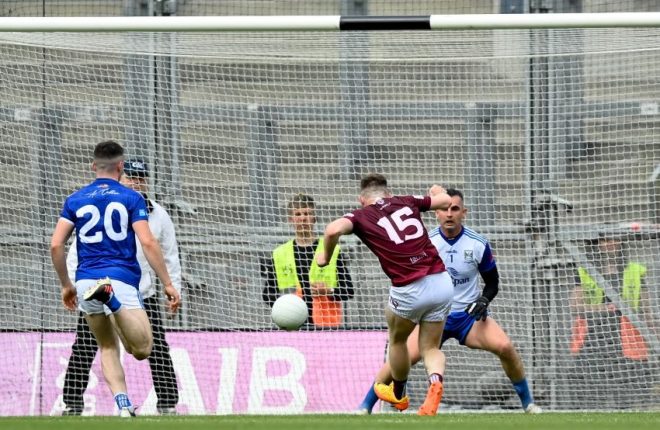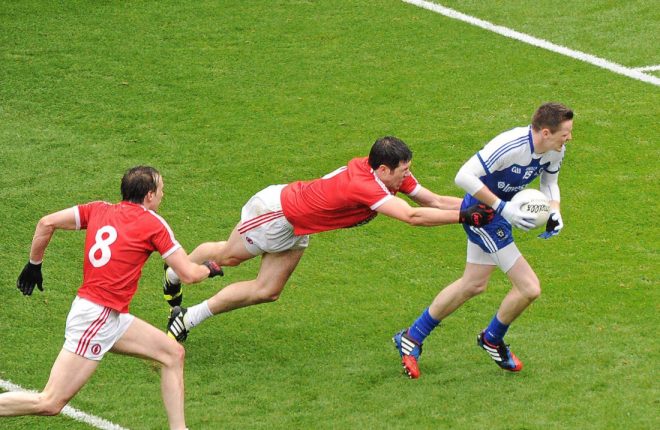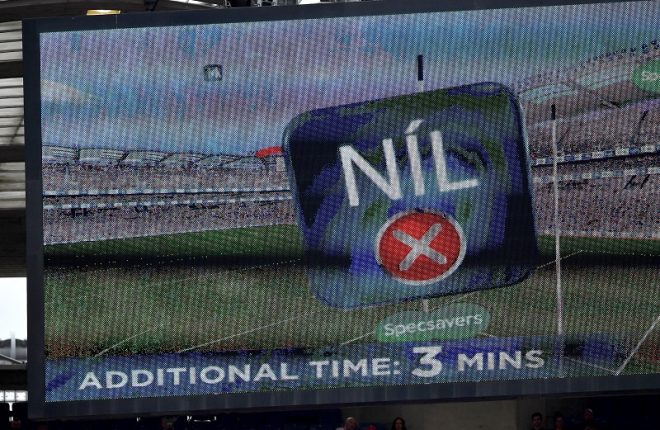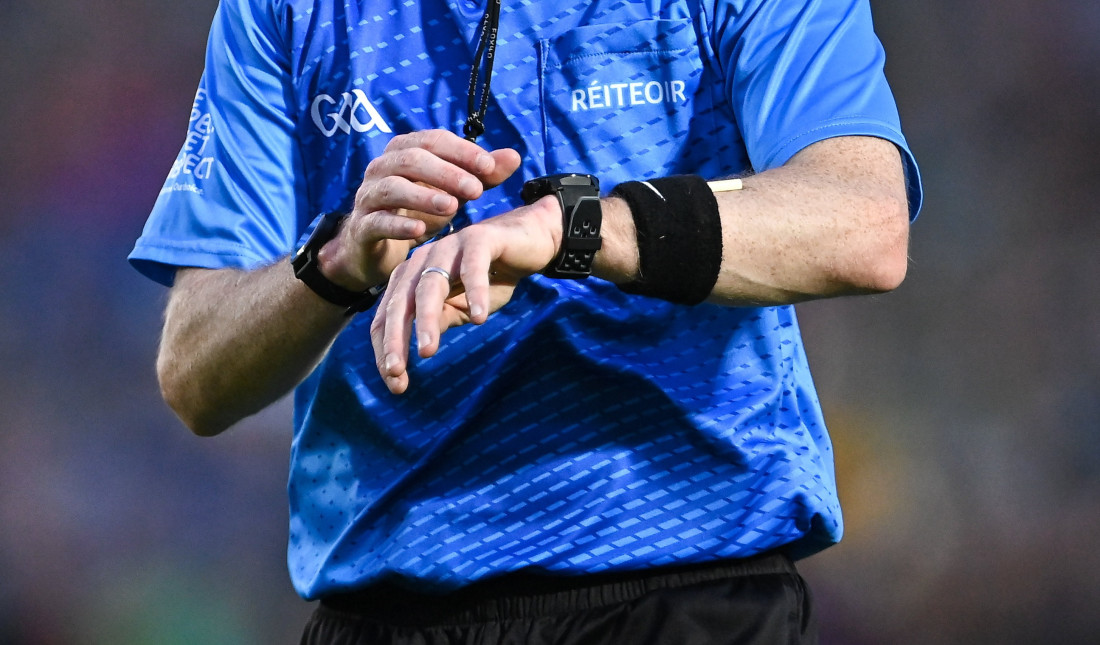By Michael McMullan
THE season never stops, but it’s now in full flow. Week after week, the pitches of Ireland are buzzing with action at all ages and levels.
Central to it all are the rules of the game but it’s not without its complications, differing opinions and the frustrations that come with it.
In some cases, the rules are not fully known. Gaelic Life asked some referees rules they find are not fully known by those who should be better informed.
Indirect free
PLAY can be stopped for instances other than a free, a wide or a ball going out of play. The team in possession when the play is stopped will be awarded a free when the referee signals for play to resume. The free will be taken from the position at which the play was stopped, unless the play was stopped inside the opponents’ 13-metre line in which case the free shall be awarded from the 13-metre line opposite the point where the play was stopped. A score may not be made directly from such a free.
Non-player intervention
IF a ball touches any non-player during play, play will be restarted by throwing in the ball between two players.
In the situation where the ball touches any non-player from a free kick, the free kick shall be retaken. However, there are two exceptions.
Firstly, if the ball – in the opinion of the referee – has been prevented from crossing the goal-line by anyone other than a player or the referee, the referee may allow the goal to stand.
Secondly, if the ball has been prevented from going over a boundary line by a non-player other than the referee, it shall be treated as having crossed the line. The referee shall make the appropriate award.
Ball on the ground
IT’S a technical foul to touch the ball on the ground with the hand(s). The ball can be lifted off the ground with the feet, but players may not lift the ball by jamming it between their knees.
There are two exceptions to the rule of not being allowed to touch the ball on the ground with their hands.
The first one is where the goalkeeper can handle it on the ground inside the small rectangle in front of their own goal.
The second one instance is when a player who falls or is knocked to the ground while in possession of the ball. They may fist or palm the ball away on the ground, and they may score in doing so.

HITTING THE NET…Lorcan Dolan slots home Westmeath’s first goal in last year’s Tailteann Cup final
Two facing two
THE referee, facing the players, starts the game and restarts it after half-time, by throwing in the ball between two players from each team, who shall stand one behind the other in their own defensive sides of the half-way line and should not be allowed to run in at an angle. All other players shall be in their respective positions behind the 45-metre lines.
Pay the penalty
A PENALTY will be awarded for any aggressive foul by a defending player inside the penalty area or any technical foul inside the small rectangle.
There is one exception to the technical foul in this instance. A goalkeeper receiving the ball directly back from the player to whom he directed a kick-out is a foul. However, if the ‘keeper has received the ball when back in the small rectangle, the referee will award a 13-metre free as opposed to a penalty.
For a penalty, only the defending goalkeeper may stand on the goal-line. They can move along but cannot advance from the goal-line until the ball is kicked.
All other players, other than the kicker, must be outside the 20-metre line and the arc – at least 13 metres from the ball until it has been kicked.
If a defending player fouls before the ball is kicked and a goal does not result, the referee shall allow the penalty kick to be retaken. Penalty takers have the option of retaking the kick or having a point scored to stand.
Keep your distance
A PENALTY can also be awarded in the situation when the defending team are facing a free on the 13-metre line. Any player within their own small rectangle must be at least 13 metres from the ball when kicked.
In a different situation, if a defending player – with a free out their own 13-metre line – plays the ball back to their goalkeeper who has stepped off the line – and not 13 metres away when kicked – the referee can award a penalty.
Frees
FOULS elsewhere result in play being restarted with a free kick or a hop ball, but there are a few exceptions. Here are some of the common ones that can lead to confusion.
If a player is fouled immediately after he plays the ball away and a score results, it shall stand. Otherwise, the referee shall award a free kick from where the foul occurred or, if more advantageous, from where the ball lands or crosses the sideline.
If the ball travels over the endline the free will be taken on the 13-metre line at the point where it crossed the endline.
However, if a diagonal pass travels over the 13-metre line and across goal but doesn’t cross the end-line, the free will be awarded from the point at which the ball crosses the 13-metre line.
Free kicks – that are not penalties or 45s – can be taken from either the hand or off the ground with the player not able to change his mind after indicating his choice to the referee.
With any frees taken from the ground, the ball must be stationary and any frees taken from the hands cannot be kicked using a drop kick method.
With the referee’s consent, a free kick may be taken immediately with the exception of a penalty kick or a free awarded to a team from their opponents’ 13m line.
Kick-outs
ALL kick-outs – after a score and a wide – are taken from the centre point of the 20-metre line and must be kicked forward.
A goalkeeper who is not taking the kick-out must stay in the small rectangle. All other players, except the player taking the kick-out, shall be outside the 20-metre line, outside the semi-circular arc and 13 metres from the ball until it has been kicked.
The player taking a kick-out may kick the ball more than once before any other player touches it but may not take the ball into his hands. It’s rare, but there is nothing to stop a ‘keeper tapping the ball off the tee and controlling the ball ‘soccer style’ into any vacant space.
The ball shall travel not less than 13 metres and outside the 20-metre line before being played by another player of the defending team. An attacking player may challenge for the ball once it is kicked.
Backpass
THE player in direct receipt of a kick-out may not pass the ball to his team’s goalkeeper without another player playing the ball. A free will be awarded from where the goalkeeper received the pass or the point on the 13-metre line opposite where it occurred. This includes the keeper not taking the kickout who is standing in the small square.
However, if the person in receipt of the ball is fouled, they may now pass the free kick back to the ‘keeper as it is deemed a new play.
Stealing yards
A PLAYER trying to take a free or a sideline kick from a more advantageous position. There is also the scenario of “breaking the line” by taking a sideline kick from inside the boundary line. Or indeed a player trying to run the clock down by delaying a free. A referee can cancel the kick and resume play with a hop ball.
Square ball
A SCORE can’t stand if the attacking team commit a square ball infringement.
A player on the attacking team cannot be inside their opponent’s small rectangle before the ball is played – the final striking action – from open play.
From a set play there is a difference. An attacking player cannot enter the small rectangle before the ball.
There are two exceptions. If an attacking player legally enters the small rectangle and the ball is played back from that area but is returned before the attacking player has time to leave, providing there is no interference with the defence. The other exception is when the ball goes high and over the bar, out of reach of all players.

THOU SHALT NOT PASS…Sean Cavanagh pulls Conor McManus down as he bore down on goal in the 2013 All-Ireland quarter-final
Black card ref
A PLAYER is shown a black card and sent to the sin-bin for 10 minutes for any of the following infractions:
1 – Deliberately pulling down an opponent
2 – Deliberately tripping an opponent with hand(s), arm, leg or foot
3 – Deliberately colliding with an opponent after they have played the ball away or for the purpose of taking him out of the movement of play.
4 – Remonstrating in an aggressive manner with a match official.
5 – Threatening or using abusive or provocative language or gestures to an opponent or teammate.
Any player who receives a second black card after returning to the play or has both a yellow and black shown at different times will then be issued with a red card and will be dismissed for the remainder of the game.
If a player is sent off within 10 minutes of the end of a game that requires extra time, the remaining time in the sin-bin carries over into extra-time.
A different penalty
AT county level, the GAA have a new ruling in place for a three-year trial as an extension to the black card ruling.
If the cynical foul (points 1-3 above) is committed inside the 20-metre line or the semi-circular arc and within 25 metres of the sideline, the referee has a decision to make.
If the cynical foul prevented the attacking team (not to be confused with the player in possession) a goal-scoring opportunity, then a penalty kick may be awarded.
A presentation on the ruling, posted on the GAA website, lists factors to consider the validity of a denied a goal-scoring chance.
Where did the foul occur? How many defenders are between the attacking player and the goals? Could another defender make a tackle before reaching the goals? How many players are in the area in front of the goals?
Making your mark
A REFEREE shall award a mark in either of the following circumstances:
1 – When a player catches the ball cleanly from a kick-out clears the defending 45-metre lines and without it touching the ground, on or past the 45-metre line nearest the kick-out point.
2 – When a player catches the ball cleanly on or inside a 45-metre line from a kick in play – not from set-play – delivered by an attacking player on or beyond the opposing team’s 45-metre line that travels at least 20-metres and without it touching the ground.
The referee must blow to signal a mark has been awarded before the player decides to either play on, take the free or – in the case of an advanced mark – avail of a free shot at the posts.
Only the player who has won the mark may take the kick, unless there is an injury where the nearest player will be instructed to take it under “exceptional” circumstances.
The player must indicate they are taking the mark by raising his arm upright. The free kick shall be taken, within 15 seconds, from the point where the mark is awarded or in line on the 13-metre line if it was won inside.
Once the player indicates he is taking the ‘mark’, the opposing players must retreat 13-metres to allow the player space to take the kick.
If a player opts not to take the free and play on, they cannot be challenged until they have taken four steps or hold the ball no longer than the time needed to do so. If the player is challenged inside that window, a free is awarded. This free can be taken by any player on the team.
The exception is when a mark is taken inside the small or large rectangle where the player may be challenged.
Do your job
A LINESMAN or umpire can only bring to the referee’s attention black, yellow and red card incidents. They can’t tell the referee any technical fouls unless the referee specifically asks.
The referee can consult with his linesmen or umpires on any matter, but they can’t go to the referee unless an incident falls into a category that warrants a yellow, red or black card.
On decisions where there is uncertainty with umpires if a ball travelled wide of the post or not, the referee can consult the linesman to see if they have an angle.
Referees select their four umpires from a pool of people who are officiating with them over many years. There will be a pre-match brief with a discussion on the level of communication. With the experience gathered over many games, there will be a two-way understanding of issues the referees will want their team to communicate with them on.

TIGHT CALL…Any ball going over the post is deemed a wide ball
Did you know?
• If the ball travels over the post, it is deemed to be a wide ball, hence Hawkeye signalling a Níl when Conor Glass wasn’t granted a point in last year’s All-Ireland semi-final when the Croke Park screen deemed it to have hit the post should the posts have been higher.
• If a ball strikes one of the sideline flags, it is deemed to have crossed the sideline. A sideline ball will be awarded against the player who last touched the ball. It is the same when a ball strikes the corner flag as it is deemed to be part of the sideline.
• Inter-county senior games are the only instances of halves lasting for the duration of 35 minutes per half. All club senior and inter-county underage games are played on the basis of 30 minutes per half. At club underage level, counties will often vary the duration at younger ages and games teams fielding less than 15 players in some grades.
• Players shown a straight red card in normal time cannot feature in extra time but the team will begin with 15 players. It’s classed a new game. There are new team sheets submitted to the referee, none of the yellow card carry over, but notings and black cards do carry over. Teams can make a further three substitutions.
Receive quality journalism wherever you are, on any device. Keep up to date from the comfort of your own home with a digital subscription.
Any time | Any place | Anywhere












